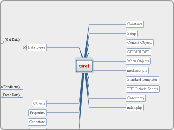TRIGONOMETRIC FUNCTIONS
COSECANTE
FORMULAS OF
COSECANT
EVEN ODD
IDENTITY
INVERSE OF
COSECANT
GRAPH OF
COSECANT
PROPERTIES OF
COSECANT
EVEN ODD
PROPERTIES
SIGNS OF
COSECANT
THE DOMAINE OF THE COSECANT FUNCTION IS THE SET OF ALL REAL NUMBERS EXCEPT INTEGERS MULTIPLES OF π(180 degrees)
• Domain: IR/{X≠Kπ},K is an integer
THE RANGE OF THE COSECANT FUNCTION CONSISTS OF ALL REAL NUMBERS LESS THAN OR EQUAL TO -1 OR GREATER THAN OR EQUAL TO 1. THAT IS
• Range: IR/{Y≤-1 OR Y≥1}
TANGENTE
FORMULAS OF
TANGENT
tan(2α) =(2tan2α)/(1-tan^2(α))
tan(α/2) =± √(1-cosα)/(1+cosα)
tan(α+β) = (tanα+tanβ)/(1-tanαtanβ)
tan(α-β) = (tanα-tanβ)/(1+tanαtanβ)
The tangent function is an odd function;
tan(-ϴ) = tan ϴ
by using the pythagorian theorem we can demonstrate that:
tan^2(ϴ) +1 = sec^2(ϴ)
Reciprocal Identity
tan ϴ = sinϴ/cosϴ and cotϴ = cosϴ/sinϴ
hence tanϴ = 1/cotϴ
tanϴ = sinϴ/cosϴ
INVERSE OF
TANGENT
The domain of the inverse function of tangent is negative infinity to infinity and the range from zero inclusive 90 degree exclusive
GRAPH OF
TANGENT
PROPERTIES OF
TANGENT
EVEN ODD
PROPERTY
the tangent function is an odd function;
tan(-ϴ) = -tan ϴ
SIGNS
The tangent function is:
-positive in the first and third quadrant
-negative in the second and fourth quadrant
The domain of tangent function is the set of all real numbers except odd integers multiple of kΠ
COTANGENTE
FORMULAS OF
COTANGENTE
PRODUCT TO
SUM
HALPH ANGLE
cot(2α) = (1-tan^2(α))/(2tan2α)
cot(α/2) =± 1/√(1-cosα)/(1+cosα)
SUM AND
DIFFERENCE
cot(α+β) = (1-tanαtanβ)/(tanα+tanβ)
cot(α-β) = (1+tanαtanβ)/(tanα-tanβ)
EVEN ODD
COTANGENT IS AN ODD FUNCTION LIKE TANGENT;
cot(-ϴ) = -cot(ϴ)
PYTHAGORIAN
using the pythagorian identity
cos^2ϴ +sin^2ϴ = 1 , and by dividing both sides by sin^ϴ, we can obtain:
cot^2ϴ +1 = csc^2ϴ
RECIPROCAL
cotϴ = 1/tanϴ
QUOTIENT
INVERSE OF
COTANGENTE
DOMAIN AND
RANGE
GRAPH OF
COTANGENTE
PROPERTIES OF
COTANGENTE
EVEN ODD
PROPERTY
SIGNS OF
COTANGENTE
SINE
FORMULAS OF
SINE
SUM TO
PRODUCT
PRODUCT
TO SUM
HALF
ANGLE
DOUBLE
ANGLE
SUM AND
DIFFERENCE
DERIVATE IDENTITY
PYTHAGORIAN
IDENTITY
sin^2ϴ + cos^2ϴ = 1
INVERSE OF SINE
GRAPH OF SINE
The periodicity is given by T=2π/w. We know that the graph of y = sin(wx) is obtained from the graph of y = sin(x) by performing a horizontal compression or stretch by a factor of 1/w. This horizontal compression replaces the interval[0,2π], which contains one period of the graph of y = sin(x), by the interval [0,2π/w], which contains one period of the graph of y = sin(wx).
In general, the value of the function
y = A sin(x), where A≠0, will always satisfy the inequality
-|A| ≤ A sin(x) ≤ |A|. The number |A| is called the amplitude of y = A sin(x)
PROPERTIES OF
SINE
EVEN ODD PROPERTIE
The sine function is an odd function there for ,
sin(-ϴ) = -sinϴ
SIGNS OF SINE
The sine function is :
-positive in the first and second quadrant;
-negative in the third and fourth quadrant
The domain of the sine function is the set of all real numbers.
The range is the set of all real numbers between -1 and 1 inclusive
SECANT
FORMULAS FOR
SECANT
sec( α/2) = 1/( √(1-cos α)/2)
sec(2ϴ) =1/(cos^2 ϴ - sin^2 ϴ)
sec(2ϴ) = 1/(1- 2sin^2 ϴ)
sec(2ϴ) = 1/( 2cos^2 ϴ - 1)
INVERSE OF
SECANT
FOR THE SECANT AND ITS INVERSE FUNCTION, THE FOLLOWING PROPERTIES HOL:
SEC^-1(SEC X) = X ; [0,pi/2)
SEC(SEC^-1 X) = X ; X LESS THAN or equal to -1 or X greater than or equal to 1
DOMAIN AND
RANGE
THE SECANT FUNCTION IS NOT A ONE-TO-ONE FUNCTION WHEN WE CONSIDER ITS ENTIRE DOMAIN, HOWEVER, WE CAN RESTRICT THAT DOMAIN TO GET AN INVERSE FUNCTION. If we restrict the domain of
y = sec(x) to the interval [0,π/2), the restricted function y = sec(x) ,
0 ≤ x < π/2 is one-to-one and hence have an inverse function which will be obtained by interchanging x and y in the function
y =f(x) = sec(x) . The implicit form of the inverse is x = sec(y) , 0 ≤ y < π/2 and we obtain
y = sec^-1(x) where
0 ≤ y < π/2
Use sum and difference to establish identities
cos(π/2 -ϴ) = sinϴ
1/cos(π/2 -ϴ) = 1/sinϴ
sec(π/2 -ϴ) = cscϴ
use double angle formula to establish identity
cos^2 ϴ =(1+cos 2ϴ)/2
sec^2 ϴ = 2/(1+cos 2ϴ)
PYTHAGORIAN
IDENTITY
sin^2 ϴ + cos^2 ϴ = 1
divide both side by cos^2 ϴ ,we will have
tan^2 ϴ + 1 = sec^2 ϴ
RECIPROCAL
IDENTITY
sec ϴ cos ϴ = 1 hence sec ϴ = 1 / cos ϴ
GRAPH OF SECANT
AMPLITUDE AND
PERIODICITY
In general, the value of the function
y = A sec(x), where A≠0, will always satisfy the inequality
-|A| ≤ Acos(x) ≤ |A|. The number |A| is called the amplitude of y = A sec(x)
The periodicity is given by T=2π/w. We know that the graph of y = cos(wx) is obtained from the graph of y = cos(x) by performing a horizontal compression or stretch by a factor of 1/w. This horizontal compression replaces the interval[0,2π], which contains one period of the graph of
y = cos(x), by the interval [0,2π/w], which contains one period of the graph of
y = cos(wx).
Since we want to graph secant in the xy-plane,we shall use the traditional symbol x for the independent variable(or argument) and y for the dependent variable(or value at x).so we write
y=f(x)=sec(x). The independent variable x represents an angle measured in radians.
since the cosine function has period 2π,we only need to graph y=f(x)=sec(x) on the interval [0,2π],the remainder will consist of repetitions of this portion.
PROPERTIE OF SECANT
EVEN ODD PROPERTIES
THE SECANTE FUNCTION IS AN EVEN FUNCTION WHICH MEANS:
SEC(-ϴ)=SEC(ϴ)
THE SECANTE FUNCTION LIKE THE COSINE FUNCTION IS A PERIODIC FUNCTION WITH PERIOD 2π
SEC(ϴ+2π)=SEC(ϴ)
SIGNS OF SECANT
BETWEEN THE INTERVAL [0,90] DEGREE,
SECANTE OF ANY ANGLE IN THAT INTERVAL IS POSITIVE,
SEC(X)>0
BETWEEN THE INTERVAL [90,180] DEGREE,
SECANTE OF ANY ANGLE IN THAT INTERVAL IS NEGATIVE,
SEC(X)<0
BETWEEN THE INTERVAL [180,270] DEGREE,
SECANTE OF ANY ANGLE IN THAT INTERVAL IS NEGATIVE,
SEC(X)<0
BETWEEN THE INTERVAL [270,0] DEGREE,
SECANTE OF ANY ANGLE IN THAT INTERVAL IS POSITIVE,
SEC(X)>0
DOMAIN AND RANGE
THE DOMAINE OF THE SECANT FUNCTION IS THE SET OF ALL REAL NUMBERS EXCEPT ODD INTEGERS MULTIPLES OF π/2(90 degrees)
• Domain: IR/{X≠Kπ/2},K is an odd integer
THE RANGE OF THE SECANT FUNCTION CONSISTS OF ALL REAL NUMBERS LESS THAN OR EQUAL TO -1 OR GREATER THAN OR EQUAL TO 1. THAT IS
• Range: IR/{Y≤-1 OR Y≥1}
COSINE
FORMULAS FOR COSINE
SUM TO PRODUCT
Sum to Product formulas
cos α + cos β = 2[cos(α+β)/2 cos(α-β)/2]
cos α - cos β =-2[sin (α+β)/2 sin(α-β)/2]
PRODUCT TO SUM
product to sum formulas
cos α cos β = (1/2)[cos(α-β)+cos(α+β)]
sin α cos β = (1/2)[sin(α+β)+sin(α-β)]
HALF ANGLE
Half angle formulas for cosine
cos α/2 = √(1-cos α)/2
DOUBLE ANGLE
Double angle formulas
cos(2ϴ) = cos^2 ϴ - sin^2 ϴ
cos(2ϴ) = 1- 2sin^2 ϴ
cos(2ϴ) = 2cos^2 ϴ - 1
DIFFERENCE
cos(α-β) = cos α cos β + sin α sin β
SUM
cos(α+β) = cos α cos β - sin α sin β
IDENTITIES
Two functions f and g are said to be identically equal if
f(x) = g(x)
for every value of x for which both functions are defined. Such an equation is referred to as an identity.
DERIVATE IDENTITIES
Use sum and difference to establish identities
cos(π/2 -ϴ) = sinϴ
use double angle formula to establish identity
cos^2 ϴ =(1+cos 2ϴ)/2
EVEN ODD IDENTITY
cos(-ϴ) = cos ϴ
PYTHAGORIAN IDENTITY
sin^2 ϴ + cos^2 ϴ = 1
RECIPROCICAL IDENTITY
sec ϴ cos ϴ = 1 hence cos ϴ = 1 / sec ϴ
QUOTIENT IDENTITY
tan ϴ = sin ϴ/cos ϴ hence
cos ϴ = sin ϴ/tan ϴ
And cot ϴ = cos ϴ / sin ϴ hence
cos ϴ = cot ϴ/ sin ϴ
INVERSE COSINE
PROPERTIES
For the cosine function and its inverse, the followings properties hold:
f^-1(f(x)) = cos^-1(cos(x)) = x ,0 ≤ x ≤ π
f(f^-1(x)) = cos(cos^-1(x))=x, -1 ≤ x ≤ 1
RANGE
The range of the inverse cosine function is the restricted domain [0,π]
DOMAINE
THE COSINE FUNCTION IS NOT A ONE-TO-ONE FUNCTION WHEN WE CONSIDER ITS ENTIRE DOMAIN, HOWEVER, WE CAN RESTRICT THAT DOMAIN TO GET AN INVERSE FUNCTION. If we restrict the domain of y = cos(x) to the interval [0,π], the restricted function y = cos(x)
0 ≤ x ≤ π is one-to-one and hence have an inverse function which will be obtained by interchanging x and y in the function
y =f(x) = cos(x) . The implicit form of the inverse is x = cos(y) , 0 ≤ y ≤ π and we obtain
y = cos^-1(x) where -1 ≤ x ≤ 1 and
0 ≤ y ≤ π
GRAPH OF COSINE
PERIODICITY
The periodicity is given by T=2π/w. We know that the graph of y = cos(wx) is obtained from the graph of y = cos(x) by performing a horizontal compression or stretch by a factor of 1/w. This horizontal compression replaces the interval[0,2π], which contains one period of the graph of y = cos(x), by the interval [0,2π/w], which contains one period of the graph of y = cos(wx).
AMPLITUDE
In general, the value of the function
y = A cos(x), where A≠0, will always satisfy the inequality
-|A| ≤ Acos(x) ≤ |A|. The number |A| is called the amplitude of y = A cos(x)
GRAPH
Since we want to graph cosine in the xy-plane,we shall use the traditional symbol x for the independent variable(or argument) and y for the dependent variable(or value at x).so we write
y=f(x)=cos(x). The independent variable x represents an angle measured in radians.
since the cosine function has period 2π,we only need to graph y=f(x)=cos(x) on the interval [0,2π],the remainder will consist of repetitions of this portion.
graph see book chapter 6 section 6.4 figure 48 , table 7 page 395
PROPERTIES OF COSINE
EVEN ODD PROPERTY
A function f is even if f(-ϴ)=f(ϴ) for all ϴ in the domain of f, function f is odd if f(-ϴ)=-f(ϴ)
for all ϴ in the domain of f.
cos(-ϴ)=cos(ϴ)
proof see book chapter 6 section 6.3 page 389
PERIOD OF COSINE
DEFINITION
A function f is called periodic if there is a positive number p such that, whenever ϴ is in the domain of f, so is ϴ+p
f(ϴ+p)= f(ϴ). ϴ is the argument of the function.
the cosine function is periodic with period 2π
cos(ϴ+2π)=cos(ϴ)
SINGS OF COS
QUADRANT IV
BETWEEN THE INTERVAL [270,0] DEGREE,
COSINE OF ANY ANGLE IN THAT INTERVAL IS POSITIVE,
COS(X)>0
QUADRANT III
BETWEEN THE INTERVAL [180,270] DEGREE,
COSINE OF ANY ANGLE IN THAT INTERVAL IS NEGATIVE,
COS(X)<0
QUADRANT II
BETWEEN THE INTERVAL [90,180] DEGREE,
COSINE OF ANY ANGLE IN THAT INTERVAL IS NEGATIVE,
COS(X)<0
QUADRANT I
BETWEEN THE INTERVAL [0,90] DEGREE,
COSINE OF ANY ANGLE IN THAT INTERVAL IS POSITIVE,
COS(X)>0
DOMAINE AND RANGE
THE DOMAINE OF THE COSINE FUNCTION IS THE SET OF ALL REAL NUMBERS, COS(X)
• Domain: IR
THE RANGE OF THE COSINE FUNCTION CONSISTS OF ALL REAL NUMBERS BETWEEN -1AND 1, INCLUSIVE
• Range: [−1,1]









